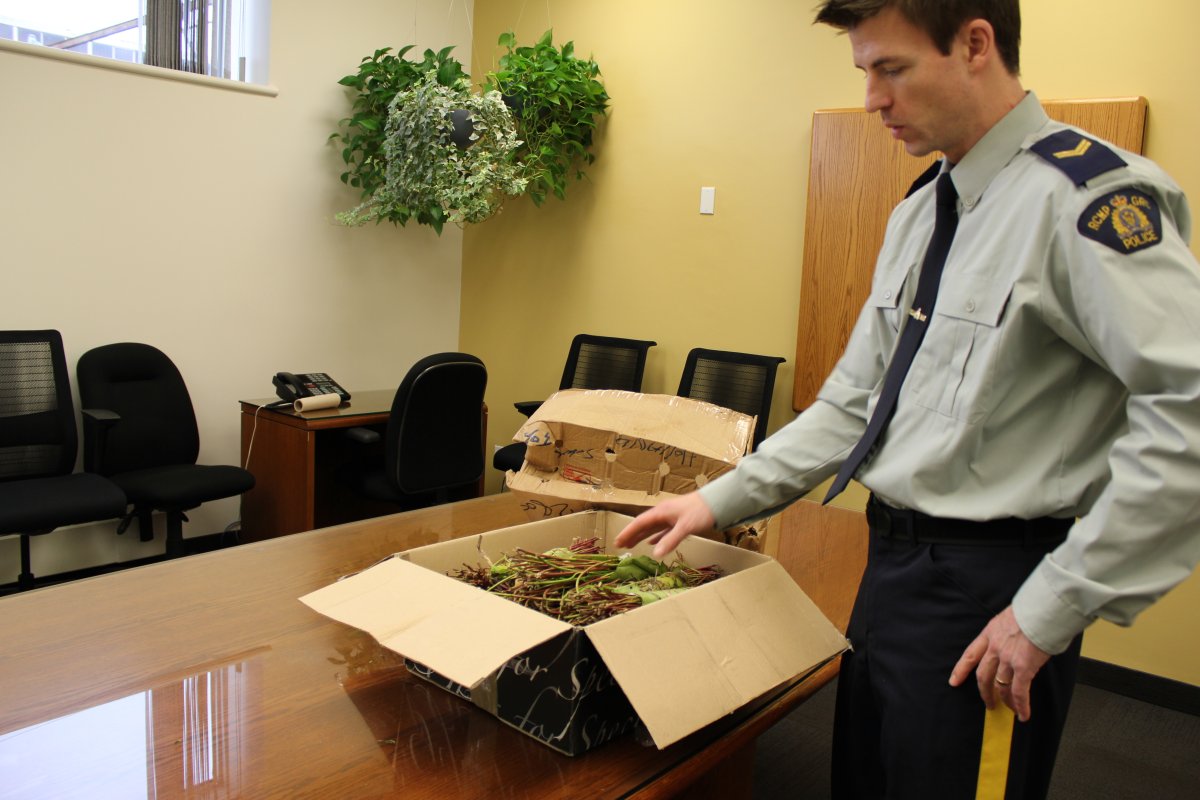It comes to Canada hidden in shipments of fresh flowers, concealed in crates of coconuts, wrapped in banana leaves and stuffed into suitcases. In Toronto, it’s seized by border guards more often than any other drug. But many Canadians have never heard of it.

It’s called khat, and more than 88 thousand kilograms of the drug were seized by Canada Border Services agents in Toronto between January 1, 2005 and July 12, 2011.
Khat, pronounced “cot” or “chat”, is a shrub native to East Africa and the Arabian Peninsula. Its leaves contain a mild stimulant. Users chew khat leaves to induce a mild feeling of euphoria or excitement.
According to CBSA files released to Global News under the Access to Information Act, khat was seized by CBSA officers 9482 times across Canada between January 1, 2005 and July 12, 2011. This makes it the third most commonly-seized drug at the Canadian border, behind marijuana and steroids. Most of it was seized in Toronto, largely at Pearson International Airport and air cargo operations.
“There’s always a seizure – between one to three every day in Toronto,” said Jerry Jesso, CBSA’s acting director of intelligence operations for the GTA. RCMP estimates are slightly more conservative, at two or three times a week. Seizure rates fluctuate with the growing season in Africa and other supply issues. In any case, a lot of khat goes through Pearson.
This is in part due to the drug’s extremely short shelf life. “From the time of cutting to the time of arrival at its final destination, they prefer to get it there between 48 and 72 hours. Otherwise the plant starts to deteriorate or rot and as it dries out or as it decomposes, it loses the stimulants that are contained in there, the narcotic content,” said Jesso.
This makes air travel pretty well the only option.
It’s a remarkably efficient system. A shipment of khat might be harvested in Kenya, flown to the United Kingdom, concealed in air cargo, flown again to Toronto’s Pearson Airport, and sold on the streets of Toronto for roughly $70 a bundle – all in less than two days.
But the biggest reason why so much khat is seized in Toronto has to do with the consumer. Most of the people who chew khat are from east African or Yemeni communities, said Corporal Heather Dickinson, RCMP Drugs and Organized Crime Awareness Coordinator for Ontario.
“Anytime you have a community where there’s Ethiopian, Somalian, Ugandan, Kenyan ex-patriates, you’re going to find this going on. You’re going to find the use there. And of course, the GTA is the biggest area for these communities.”
“Khat is a part and parcel of the Somali culture. It’s entrenched,” said Mohamed Doli, a Somali-Canadian lawyer in Toronto. “If you go to places like Kenya or Yemen, you will find a whole family sitting down and chewing khat.” However, some Somali community leaders are careful to draw a line between the drug users and ordinary members of the community.
Doli believes the harms associated with khat use have been exaggerated. “In places where khat is used, like Kenya or Yemen, where it is like taking a cup of coffee or tea, people are very normal,” he said.
“You will not see homeless people because they have become addicted to khat as we do see alcoholics or people who abuse other substances. Do people waste time? Of course people waste time sitting around chewing khat and talking. But there are no proven social effects that so far have been documented.”
Dickinson disagrees. “There are some long term effects from using this stuff, it’s not like you can just use it and there aren’t any harmful effects,” she said. She said that chronic users can experience medical problems like anxiety, panic attacks, hallucinations, gastro-intestinal issues and impotence.
“At the end of the day, this type of use, like with any drug use, it inhibits your ability to do certain things. And once you have the stimulation and the crash that goes along with the khat, you can expect to have reduced work hours, decreased production and income, and for those that are getting caught with it, the court costs involved as well.”
These court costs are a major concern for Doli. “I don’t want to appear that I’m supporting the importation of khat into Canada. In fact, I do not want khat to be allowed into the country,” he said.
“But the criminalization of khat and charging and imprisoning those who are found with it, is completely in my view, a very unfortunate and very discriminatory in nature because people whom it affects have no power in Canada.”
Current drug laws for khat are a bit complex. Possession of khat itself is not a criminal offence if for personal use. Trafficking in khat or importing it can lead to a maximum sentence of three years in prison. However, one of the active ingredients in khat, cathinone, falls into a stricter category of prohibited drug, where possession can carry a maximum sentence of three years in prison, or a summary conviction leading to fines or jail time. This means that people who possess the plant could face serious consequences, as by default, they are also holding cathinone.
These laws unfairly target the east African community, said Doli. He would prefer that khat be legalized and regulated as an agricultural product, so that the importation is still controlled, but individuals caught trying to bring it into the country would not face jail time.



Comments